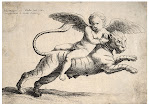Dave’s mom is well aware of my fragrance fixation, and she has given me some lovely gifts of new and vintage perfume over the years. Dave had a birthday in March and she sent him some artisan pottery, which he collects. As part of the packing material for the pots--and with me in mind--she threw in several dozen old carded perfume samples she had cleared out of a drawer. Most of them date from the early to mid-80s, when samps were still generously handed out at cosmetic counters. (Yes, boys and girls, there was a time within living memory when just buying eye shadow or mascara could get you a handful of new scents to test. How quickly civilization declines.)
A lot of the samps are fragrances that were introduced in the decade of big shoulders and have since become reliable warhorses: Poison, Diva, Red Door, and (gasp!) Giorgio, among others. Most of these don’t seem to have changed at all over the years, so I won’t bother reviewing them. You may get some thoughts from me soon on the notorious Giorgio, but for now I’ll stick to blogging about some of the rarities in my little treasure trove.
The
original Galanos, launched in 1979, is a scent I vaguely recall as an establishment glamour frag, something that a bookish, pinko, Goodwill fashion plate like me wouldn’t have been caught dead wearing. (A reviewer on Basenotes mentions that James Galanos was Nancy Reagan’s favorite designer--a fact I had happily forgotten, but which probably accounts for my attitude toward the perfume.)

I’m still bookish, pinko, etc., and I recoil from Nancy Reagan as much as I ever did, but I cannot deny that Galanos is a wonderful fragrance. A love child of Youth Dew and Tabu, this smooth oriental has a bouquet of flowers in its heart, and there’s an irresistible mossiness in the base that is missing from both parents. It lacks the slightly harsh woody notes of Youth Dew, and though it’s not exactly vegan, it does not have the funky civet smack of Tabu. The drydown is ambery and floral, with hints of tonka and vetiver. “Refined” and “mature” are the adjectives it brings to mind. It would make a fine signature for one of Louise Dahl-Wolfe’s style goddesses.
(I should point out that the scent I’m talking about is an EDT of the first incarnation of Galanos, which was presented in a bronze packaging with green and/or black accents. The scent was relaunched in the mid-90s in a blue box, and I believe it was tweaked, if not wholly reformulated, at the same time. It’s been discontinued altogether now, and pretty much all the remaining stock seems to be the later formula. A few bottles of the first version are floating around ebay.)
One of the surprising things about this collection of samples is how many of them are parfum. There’s even a vial of Chanel No. 5 in parfum. I can’t imagine Chanel tossing around such freebies today. But as happy as I am to have the little taste of No. 5, I’m even more delighted that the samp of Ivoire de Balmain (1980) is parfum as well. Ivoire EDT is a staple of my fragrance wardrobe and I had never had a chance to try the parfum, which is pretty scarce, until now.

Keeping in mind that age tends to diminish top notes, I find that this parfum concentration is less assertively green than the EDT. The brisk dose of galbanum I’m accustomed to is quite muted here. There’s a hint of soft lemon, a bit of bubbly aldehyde, and then it’s straight to the floral heart, where jasmine and hyacinth are dominant. I’ve always been baffled by the inclusion of
carnation in the list of notes for Ivoire, since I can’t find it all in the EDT, but the parfum has a rich carnation note that fleshes out the composition very nicely.
The moss in the base is a chypre lover’s dream, and it’s accompanied by a light amber that lends warmth and sensuality to what I’ve always considered a rather austere scent. If you love Ivoire and you can afford the prices (e.g., $29 for a 2 ml sample), then I’d say the parfum is well worth pursuing. Personally, I’ve sworn to resist the chase, but we’ll see how long I hold out once this vial is gone.
I think this post is quite long enough, so I’ll stop here and return to the 21st century. Check back later for a few words on Ombre d’Or, the original Mackie and other faded beauties.
Mary Jane Russell in Dior Dress, Paris, 1950, photographed by Louise Dahl-Wolfe. Image from the website of
Christie's.Invocation (detail), Frederick Leighton, c.1880. Image from
Wikimedia Commons.





























